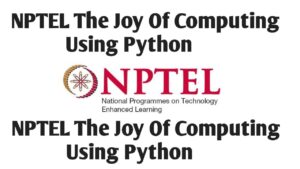Nptel The Joy of Computing Using Python Week 10 Assignment Answers
Searching for the Week 10 answers of the Nptel The Joy of Computing Using Python course? You’re in the right spot! Here, you’ll find reliable and up-to-date solutions to help you complete your Week 10 assignment with confidence.

The Joy of Computing using Python
ABOUT THE COURSE :
INTENDED AUDIENCE : Any interested audience
PREREQUISITES : 10th standard/high school
INDUSTRY SUPPORT : Every software company is aware of the potential of a first course in computer science. Especially of a first course in computing, done right.
COURSE LAYOUT – Click To Know More
- Motivation for Computing
- Welcome to Programming!!
- Variables and Expressions : Design your own calculator
- Loops and Conditionals : Hopscotch once again
- Lists, Tuples and Conditionals : Lets go on a trip
- Abstraction Everywhere : Apps in your phone
- Counting Candies : Crowd to the rescue
- Birthday Paradox : Find your twin
- Google Translate : Speak in any Language
- Currency Converter : Count your foreign trip expenses
- Monte Hall : 3 doors and a twist
- Sorting : Arrange the books
- Searching : Find in seconds
- Substitution Cipher : What’s the secret !!
- Sentiment Analysis : Analyse your Facebook data
- 20 questions game : I can read your mind
- Permutations : Jumbled Words
- Spot the similarities : Dobble game
- Count the words : Hundreds, Thousands or Millions.
- Rock, Paper and Scissor : Cheating not allowed !!
- Lie detector : No lies, only TRUTH
- Calculation of the Area : Don’t measure.
- Six degrees of separation : Meet your favourites
- Image Processing : Fun with images
- Tic tac toe : Let’s play
- Snakes and Ladders : Down the memory lane.
- Recursion : Tower of Hanoi
- Page Rank : How Google Works !!
Nptel The Joy of Computing Using Python Week 10 Assignment Answers
1. Which of the following statements is correct about Python’s dynamic typing?
a) Variables must be declared before use.
b) A variable’s type can change at runtime.
c) Python does not allow reassignment of variable types.
d) Python is statically typed.
View Answer
2. What will be the output of the following code?
a) toPmiagmnrh
b) toPmiagmnrPg
c) tnoaigmooP
d) toPmiagmnr
View Answer
3. What does the following code print?
a) 6
b) 7
c) 9
d) Value Error
View Answer
4. Which statement about find() and index() in Python is true?
a) Both return -1 if the substring is not found.
b) index() raises an error if not found, but find() returns -1.
c) index() and find() behave identically.
d) Both return the first index of occurrence.
View Answer
For Latest Update Join our official channel: Click here to join
5. What will be the output of the following Python code?
print(17 % -5)
a) 3
b) 2
c) 0
d) -3
View Answer
6. Which method in PIL is used to resize an image while maintaining the aspect ratio?
a) resize()
b) thumbnail()
c) reshape()
d) aspect ratio resize()
View Answer
7. Which of the following correctly finds all numbers divisible by 3 but not by 5 in a list?
nums = range(1, 50)
a) [x for x in nums if x % 3 == 0 and x % 5 != 0]
b) [x for x in nums if x % 5 != 0 or x % 3 == 0]
c) [x for x in nums if x % 3 != 0 and x % 5 == 0]
d) filter(lambda x: x % 3 == 0 and x % 5 == 0, nums)
View Answer
8. What will be the output of the following code?
a) 2
b) 5
c) [5, 6]
d) 4
View Answer
For Latest Update Join our official channel: Click here to join
9. For which value of axis the output is [5, 7, 9] in the below code?
a) 0
b) 1
c) 2
d) axis argument is not required.
View Answer
10. What will be the shape of the resulting NumPy array?
a) (3, 2)
b) (4, 3)
c) (3, 4)
d) (4, 2)
View Answer
Nptel The Joy Of Computing Using Python Week 11 Assignment Answers – Click Here